 Do you plan to sell any products online to an online audience? If so, then here’s a good idea: consider providing users with currency conversion.
Do you plan to sell any products online to an online audience? If so, then here’s a good idea: consider providing users with currency conversion.
Currency conversion tools allow your prospects to have the price of a foreign currency transaction converted to their local currency at the buying or checkout phase. It also lets customers see the exact amount their card or PayPal account will be charged, expressed in their home currency.
One advantage of adding currency conversion to your site is that it allows your customers to view and understand prices in foreign countries in their own home currency, making it it easier for customers to work out their costs and expenses.
If your site is powered by WordPress, it’s quite easy and simple to add a currency converter to your WP website, allowing your site visitors to quickly determine the cost of your goods.
Currencyr – Currency Converting Tool For WordPress
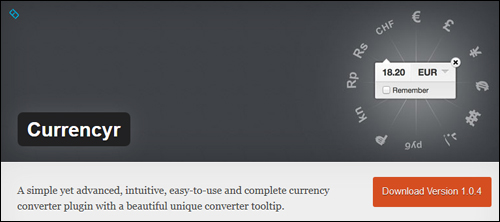
Currencyr is a simple, easy-to-use and complete currency converter WP plugin with a visually attractive converter tooltip. And, it’s 100% free!
This plugin includes great features such as:
- In-line conversion tool
- Supports a number of exchange rates providers, such as Yahoo! and FoxRates
- WP-Cron task scheduler enabled
- Widgetized currency table and converter
- Supports integration with various e-commerce plugins like WooCommerce, Shop & Easy Digital Downloads.
- Can detect local currency automatically
- Translation support
Note: This plugin requires your server to be running PHP 5.3.0 or later. Do not use this plugin if you currently have an older version of PHP installed on your server. Alternatively, ask your web hosting company to check and upgrade your PHP.
***
You can install the plugin from your WordPress dashboard by typing in “currencyr” into the Plugins search field and clicking the ”Install Now” button …
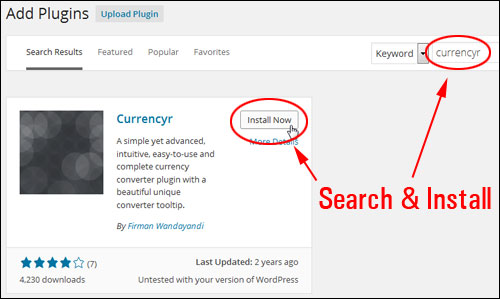
After you have installed and activated the plugin, you can access the plugin’s settings by selecting Currencyr from your WP dashboard navigation menu …
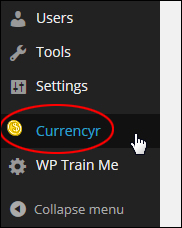
The plugin settings screen offers you several configuration options …
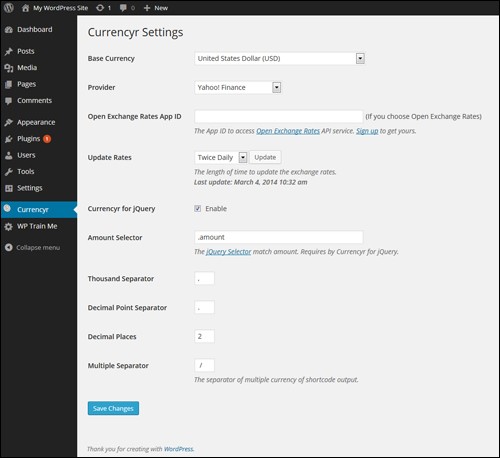
For example, you can choose a base currency from a dropdown menu. The default option is ’US Dollar’ …
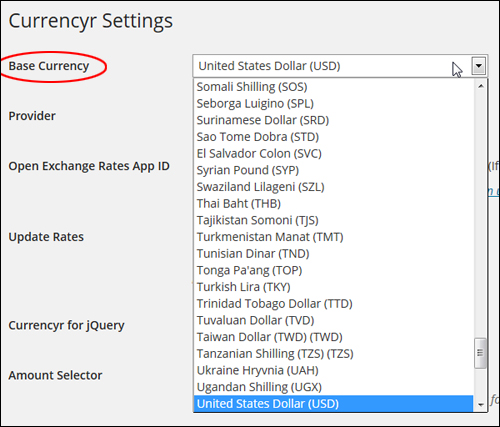
You can also specify a data provider from a dropdown menu. The default provider is Yahoo Finance, but you can also choose another provider, like FoxRate or Google Finance …

Note: If you choose ‘Open Exchange Rates’, an API (Application Programming Interface) is required …

You can select how often you want to update the currency exchange rates by specifying an option from the ‘Update Rates’ dropdown menu …

The plugin uses jQuery, which allows web developers to add things like animation effects to web applications (such as WordPress plugins).
Unless there is a reason to modify the jQuery settings, leave these as they are …

Edit the remainder of the plugin settings and don’t forget to click Save Changes when finished …
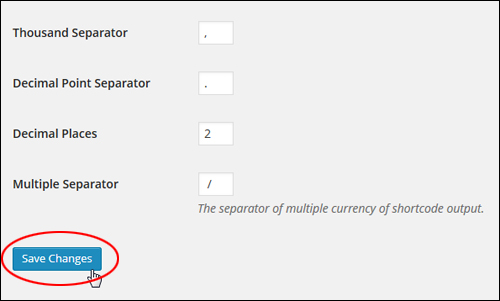
Once you have configured your settings, you can add currency conversion to any WP page or post using shortcodes and widgets.
Refer to the ‘Additional Plugin Notes’ section further below to learn more about using currency codes (e.g. USD, AUD, ZAR, etc …) in this plugin.
Plugin Shortcodes
You can easily add currency conversion to pages, posts and widgets with no technical knowledge using shortcodes.
Here are some examples of currency shortcodes that you can add to pages and posts:
Let’s say that you retail a product online for a fixed amount (e.g. $175) in US Dollars (USD), and you want to show the amount converted into British pounds (GBP) on your product information page.
All you need to do is insert the following shortcode to your post or page …

Note: You can also display pricing in dollars and cents (for example, 155.25, 29.95, 400.00, etc …)
The screenshot below shows how your shortcode looks when inserting it into a product page …
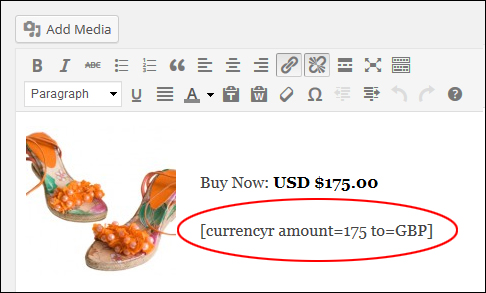
After the content has been published, the currency conversion will then appear like this …
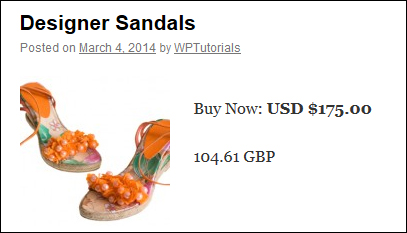
Using the same example, let’s now display the same amount into different currency formats.
To do this, use the shortcode shown below (add as many currency symbols as you like separated by vertical pipes) …

The screenshot below now shows how the shortcode looks when you add it to a post …

Once the page has been published, your converted currency will then display as shown below …
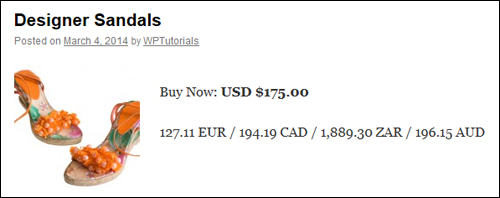
See the ‘Additional Plugin Notes’ section further below to learn more about changing the currency separator symbol in this plugin.
Now, suppose you want to use a different base currency than the one set as the default.
For example, say you have set your default base currency as EUR and you have a section on your website targeted to non-European customers (like Australia or Canada), you can change the base currency using the following shortcode …

You can see how the shortcode appears when added to your content …
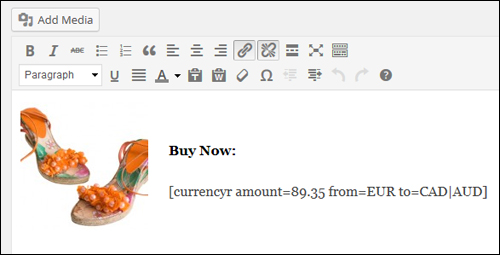
Once your post has been published, your converted currency will then display as seen below …
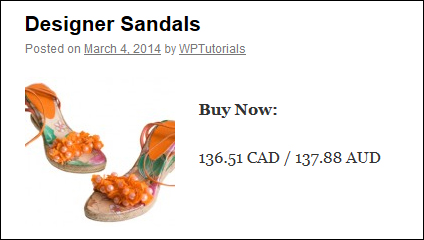
Widget
You can also insert a currency converter into your website’s sidebar menu using a widget.
To add the currency converter to your sidebar menu, select Appearance > Widgets in the WP admin menu …
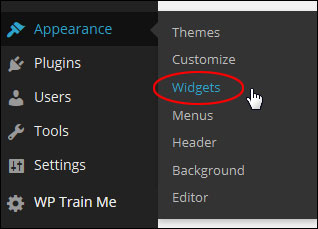
In the Widgets > Available Widgets area find the ‘Currencyr’ widget and add it to an ‘Active Widgets’ area …
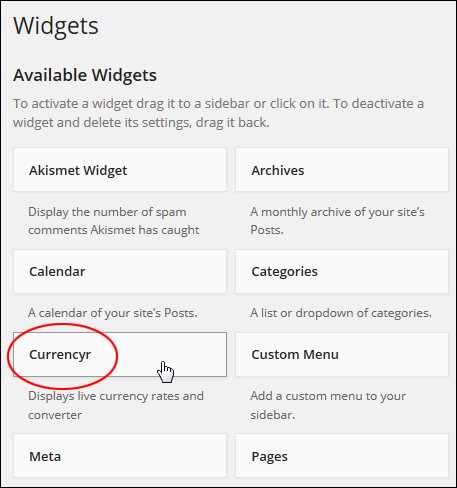
Configure the widget options as shown in the screenshot below (add any currency codes you want to display on your widget separated by a comma), and click Save to save your settings …
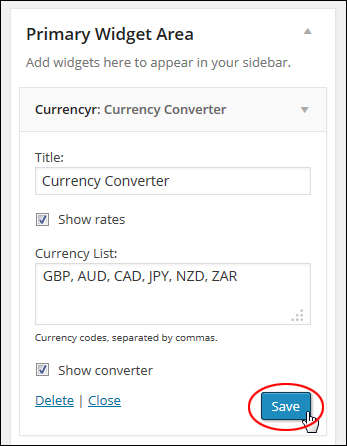
The currency converter will now appear on the sidebar menu with the settings you have specified when configuring the widget …
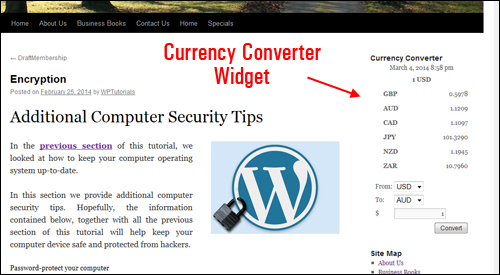
Additional Plugin Notes
Here are some additional notes and useful information about using the plugin.
Currency Separator
The Currencyr plugin allows you to specify the symbol to display as the currency separator when using several currencies.
You can select a different symbol in the ‘Multiple Separator’ settings field.
So, for example, entering the default symbol “/” (forward slash) …

Displays your currency values separated by the forward slash as you can see in the screenshot below …
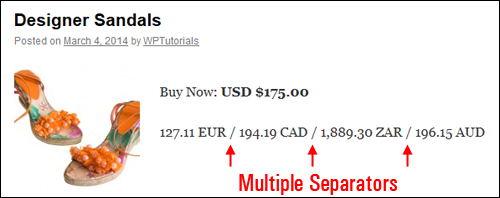
If you enter another symbol and resave your plugin settings …

Your web visitors will see the new symbol used as the currency separator …
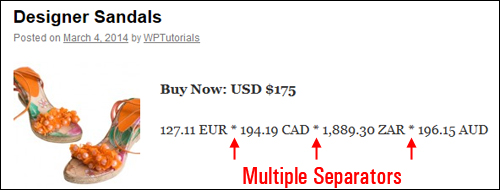
e-Commerce Software Integration
As described earlier, the plugin can be integrated with a number of WordPress-compatible e-commerce plugins such as WooCommerce and Easy Digital Downloads …
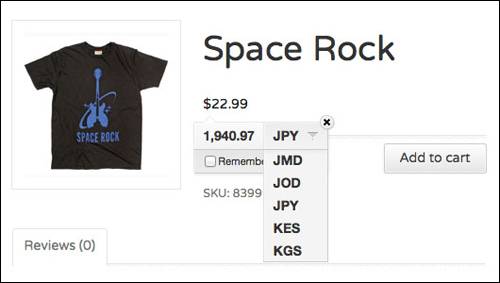
(image source: Currencyr plugin site)
And there you have it! Now you can go and easily add a currency converter to your e-commerce web site.
To learn more about WordPress e-commerce plugins, see the tutorial below:
***
"Wow! I never knew there's so much to learn about WordPress! I bought one of the WordPress for Dummies three years ago, such authors need to be on this course!" - Rich Law, Create A Blog Now

